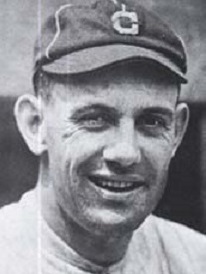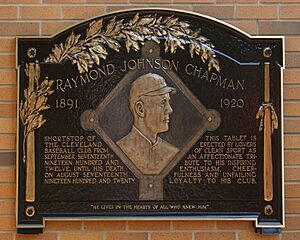Ray Chapman facts for kids
Quick facts for kids Ray Chapman |
|||
|---|---|---|---|
 |
|||
| Shortstop | |||
| Born: January 15, 1891 Beaver Dam, Kentucky, U.S. |
|||
| Died: August 17, 1920 (aged 29) Manhattan, New York, U.S. |
|||
|
|||
| debut | |||
| August 30, 1912, for the Cleveland Indians | |||
| Last appearance | |||
| August 16, 1920, for the Cleveland Indians | |||
| MLB statistics | |||
| Batting average | .278 | ||
| Home runs | 17 | ||
| Runs batted in | 364 | ||
| Teams | |||
|
|||
| Career highlights and awards | |||
|
|||
Raymond Johnson Chapman (born January 15, 1891 – died August 17, 1920) was an American baseball player. He played his entire career as a shortstop for the Cleveland Indians team.
Tragically, Chapman was hit in the head by a pitch during a game. He died 12 hours later. As of today, he is the only player to die directly from an injury during a major league game. His death changed baseball forever. It led to new rules, like umpires having to replace dirty balls. It also helped ban the "spitball" pitch. Chapman's death was also a reason why batting helmets were later required. However, it took over 30 years for this rule to be put in place.
Contents
Ray Chapman's Early Life
Chapman was born in Beaver Dam, Kentucky. He grew up in Herrin, Illinois.
A Star Baseball Career
Chapman started playing in the major leagues in 1912. He joined the Cleveland team, which was then called the Naps.
He was a great player. In 1918, Chapman led the American League in runs scored and walks. He was also very good at bunting. He holds the record for the most sacrifice hits in one season, with 67 in 1917. A sacrifice hit helps a teammate move to the next base.
Chapman was also an excellent shortstop. He led the league in assists once. He had a batting average of .300 or better three times. He also led the Indians in stolen bases four times. In 1917, he set a team record with 52 stolen bases. This record stood until 1980. When he died, he was hitting .303 and had scored 97 runs.
Many people thought 1920 would be Chapman's last year playing baseball. He had just married Kathleen Daly. Her father was a well-known businessman in Cleveland. Chapman planned to retire and join his new family's business. He also wanted to start his own family.
The Tragic Day
On August 16, 1920, Chapman was playing against the New York Yankees. The game was at the Polo Grounds. During the game, he was hit in the head by a pitch from Carl Mays.
Back then, pitchers often made the baseballs dirty. They would use dirt, licorice, or tobacco juice. They also scuffed or cut the balls. This made the ball hard to see and made it move strangely. Mays threw with a special "submarine" style, throwing underhand. It was also late in the afternoon, making it even harder to see.
People who saw it said Chapman didn't even react to the pitch. He probably couldn't see it coming. The sound of the ball hitting his head was so loud. Mays thought it had hit Chapman's bat. He even picked up the ball and threw it to first base.
The umpire, Tommy Connolly, saw blood from Chapman's ear. He quickly called for a doctor. Teammates rushed to Chapman. Carl Mays just stood on the mound. Chapman tried to walk but fell. As his teammates helped him off the field, he mumbled, "I'm all right; tell Mays not to worry... ring....Katie's ring." Then he passed out.
Chapman was taken to St. Lawrence Hospital. Doctors found a serious skull fracture. They performed emergency surgery to help his brain. But Chapman died at 4:40 a.m. the next day. His wife, Katie, was pregnant. She arrived from Cleveland and fainted when she heard the news.
Thousands of people attended Chapman's funeral in Cleveland. He was buried at Lake View Cemetery.
The Cleveland players wore black armbands for the rest of the season. The Indians went on to win the 1920 World Series. They dedicated their victory to Ray Chapman.
Honoring Ray Chapman

A bronze plaque was made to remember Chapman. Fans donated money for it. It was first hung at League Park. Later, it moved to Cleveland Stadium in 1946. In the 1970s, it was taken down for unknown reasons.
In 2007, the plaque was fixed up. It became part of Progressive Field's Heritage Park. This park honors the team's history and the Cleveland Guardians Hall of Fame. Chapman was added to the team's Hall of Fame in 2006. This was the first group of new members since 1972. There is also a baseball field named after Ray Chapman in his hometown of Beaver Dam, Kentucky.
More to Explore
- List of baseball players who died during their careers
- John Dodge, another player killed by a pitched ball in a minor league game
- Phillip Hughes, a cricketer who died from a ball injury in 2014


